9 Biodiversity & How So Many Species are Maintained in a Community
By the end of this chapter you will be able to:
- Explain how the Island Biogeography Theory supports biodiversity in a community
- Explain how the Intermediate Disturbance Theory supports biodiversity in a community
- Describe the different types of biodiversity
- Explain the value of biodiversity to humans and the environment
Introduction
Biodiversity is a broad term for biological variety, and it can be measured at a number of organizational levels. Traditionally, ecologists have measured biodiversity by taking into account both the number of species and the number of individuals in each of those species. However, biologists are using measures of biodiversity at several levels of biological organization (including genes, populations, and ecosystems) to help focus efforts to preserve the biologically and technologically important elements of biodiversity.
When biodiversity loss through extinction is thought of as the loss of species such as the passenger pigeon, the dodo, or, even, the woolly mammoth it is hard to see the relevance since it occurred so long ago. How is the loss practically important for the welfare of the human species? Would these species have made our lives any better? From the perspective of evolution and ecology, the loss of a particular individual species, with some exceptions, may seem unimportant, but the current accelerated extinction rate means the loss of tens of thousands of species within our lifetimes. Much of this loss is occurring in tropical rainforests, which are especially high-diversity ecosystems that are being cleared for timber and agriculture. This is likely to have dramatic effects on human welfare through the collapse of ecosystems and in added costs to maintain food production, clean air and water, and improve human health.
Biologists recognize that human populations are embedded in ecosystems and are dependent on them, just as is every other species on the planet. Agriculture began after early hunter-gatherer societies first settled in one place and heavily modified their immediate environment: the ecosystem in which they existed. This cultural transition has made it difficult for humans to recognize their dependence on living things other than crops and domesticated animals on the planet. Today our technology smooths out the extremes of existence and allows many of us to live longer, more comfortable lives, but ultimately the human species cannot exist without its surrounding ecosystems. Our ecosystems provide our food. This includes living plants that grow in soil ecosystems and the animals that eat these plants (or other animals) as well as photosynthetic organisms in the oceans and the other organisms that eat them. Our ecosystems have provided and will provide many of the medications that maintain our health, which are commonly made from compounds found in living organisms. Ecosystems provide our clean water, which is held in lake and river ecosystems or passes through terrestrial ecosystems on its way into groundwater.
Watch this video on why humans should care about biodiversity.
Types of Biodiversity
A common meaning of biodiversity is simply the number of species in a location or on Earth, referred to as species richness. For example, the American Ornithologists’ Union lists 2078 species of birds in North and Central America. This is one measure of the bird biodiversity on the continent. More sophisticated measures of diversity take into account the relative abundances of species. For example, a forest with 10 equally common species of trees is more diverse than a forest that has 10 species of trees wherein just one of those species makes up 95 percent of the trees rather than them being equally distributed. Biologists have also identified alternate measures of biodiversity, some of which are important in planning how to preserve biodiversity.
Genetic diversity is one alternate concept of biodiversity. Genetic diversity (or variation) is the raw material for adaptation in a species. A species’ future potential for adaptation depends on the genetic diversity held in the genomes of the individuals in populations that make up the species. The same is true for higher taxonomic categories. A genus with very different types of species will have more genetic diversity than a genus with species that look alike and have similar ecologies. The genus with the greatest potential for subsequent evolution is the most genetically diverse one.
Most genes code for proteins, which in turn carry out the metabolic processes that keep organisms alive and reproducing. Genetic diversity can also be conceived of as chemical diversity in that species with different genetic makeups produce different assortments of chemicals in their cells (proteins as well as the products and byproducts of metabolism). This chemical diversity is important for humans because of the potential uses for these chemicals, such as medications. For example, the drug eptifibatide is derived from rattlesnake venom and is used to prevent heart attacks in individuals with certain heart conditions.
At present, it is far cheaper to discover compounds made by an organism than to imagine them and then synthesize them in a laboratory. Chemical diversity is one way to measure diversity that is important to human health and welfare. Through selective breeding, humans have domesticated animals, plants, and fungi, but even this diversity is suffering losses because of market forces and increasing globalism in human agriculture and migration. For example, international seed companies produce only a very few varieties of a given crop and provide incentives around the world for farmers to buy these few varieties while abandoning their traditional varieties, which are far more diverse. The human population depends on crop diversity directly as a stable food source and its decline is troubling to biologists and agricultural scientists.
It is also useful to define ecosystem diversity: the number of different ecosystems on Earth or in a geographical area. Whole ecosystems can disappear even if some of the species might survive by adapting to other ecosystems. The loss of an ecosystem means the loss of the interactions between species, the loss of unique features of coadaptation, and the loss of biological productivity that an ecosystem is able to create. An example of a largely extinct ecosystem in North America is the prairie ecosystem (Fig 1). Prairies once spanned central North America from the boreal forest in northern Canada down into Mexico. They are now all but gone, replaced by crop fields, pasture lands, and suburban sprawl. Many of the species survive, but the hugely productive ecosystem that was responsible for creating our most productive agricultural soils is now gone. As a consequence, their soils are now being depleted unless they are maintained artificially at greater expense. The decline in soil productivity occurs because the interactions in the original ecosystem have been lost; this was a far more important loss than the relatively few species that were driven extinct when the prairie ecosystem was destroyed.

Figure 1: The variety of ecosystems on Earth—from coral reef to prairie—enables a great diversity of species to exist. (credit “coral reef”: modification of work by Jim Maragos, USFWS; credit: “prairie”: modification of work by Jim Minnerath, USFWS)
Importance of Biodiversity
Loss of biodiversity eventually threatens other species we do not impact directly because of their interconnectedness; as species disappear from an ecosystem other species are threatened by the changes in available resources. Biodiversity is important to the survival and welfare of human populations because it has impacts on our health and our ability to feed ourselves through agriculture and harvesting populations of wild animals.
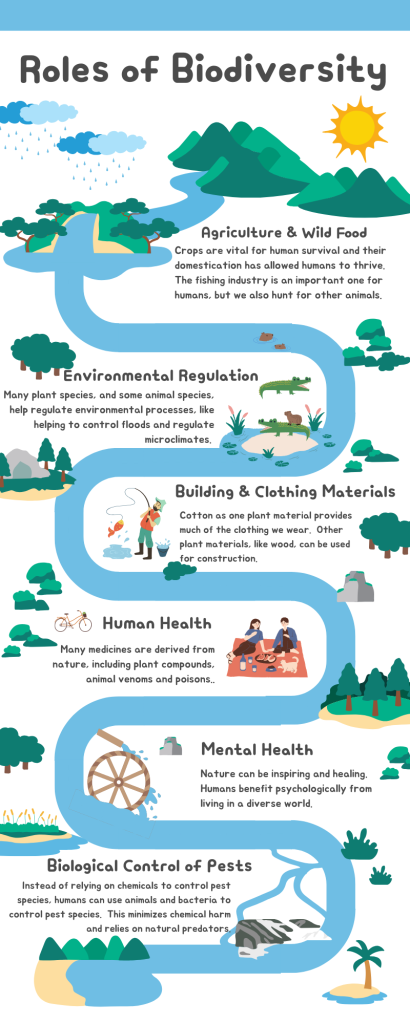
Human Health
Many medications are derived from natural chemicals made by a diverse group of organisms. For example, many plants produce secondary plant compounds, which are toxins used to protect the plant from insects and other animals that eat them. Some of these secondary plant compounds also work as human medicines. Contemporary societies that live close to the land often have a broad knowledge of the medicinal uses of plants growing in their area. For centuries in Europe, older knowledge about the medical uses of plants was compiled in herbals—books that identified the plants and their uses. Humans are not the only animals to use plants for medicinal reasons. The other great apes, orangutans, chimpanzees, bonobos, and gorillas have all been observed self-medicating with plants.
Modern pharmaceutical science also recognizes the importance of these plant compounds. Examples of significant medicines derived from plant compounds include aspirin, codeine, digoxin, atropine, and vincristine (Fig 2). Many medications were once derived from plant extracts but are now synthesized. It is estimated that, at one time, 25 percent of modern drugs contained at least one plant extract. That number has probably decreased to about 10 percent as natural plant ingredients are replaced by synthetic versions of the plant compounds. Antibiotics, which are responsible for extraordinary improvements in health and lifespans in developed countries, are compounds largely derived from fungi and bacteria.

Figure 2: Catharanthus roseus, the Madagascar periwinkle, has various medicinal properties. Among other uses, it is a source of vincristine, a drug used in the treatment of lymphomas. (credit: Forest and Kim Starr)
In recent years, animal venoms and poisons have excited intense research for their medicinal potential. By 2007, the FDA had approved five drugs based on animal toxins to treat diseases such as hypertension, chronic pain, and diabetes. Another five drugs are undergoing clinical trials and at least six drugs are being used in other countries. Other toxins under investigation come from mammals, snakes, lizards, various amphibians, fish, snails, octopuses, and scorpions.
Aside from representing billions of dollars in profits, these medications improve people’s lives. Pharmaceutical companies are actively looking for new natural compounds that can function as medicines. It is estimated that one third of pharmaceutical research and development is spent on natural compounds and that about 35 percent of new drugs brought to market between 1981 and 2002 were from natural compounds.
Finally, it has been argued that humans benefit psychologically from living in a biodiverse world. The chief proponent of this idea was entomologist E.O.Wilson. He argues that human evolutionary history has adapted us to living in a natural environment and that built environments generate stresses that affect human health and well-being. There is considerable research into the psychologically regenerative benefits of natural landscapes that suggest the hypothesis may hold some truth.
Watch this short video with E.O. Wilson reading part from his book along with some beautiful images of species.
Agricultural
Since the beginning of human agriculture more than 10,000 years ago, human groups have been breeding and selecting crop varieties. This crop diversity matched the cultural diversity of highly subdivided populations of humans. For example, potatoes were domesticated beginning around 7,000 years ago in the central Andes of Peru and Bolivia. The people in this region traditionally lived in relatively isolated settlements separated by mountains. The potatoes grown in that region belong to seven species and the number of varieties likely is in the thousands. Each variety has been bred to thrive at particular elevations and soil and climate conditions. The diversity is driven by the diverse demands of the dramatic elevation changes, the limited movement of people, and the demands created by crop rotation for different varieties that will do well in different fields.
Potatoes are only one example of agricultural diversity. Every plant, animal, and fungus that has been cultivated by humans has been bred from original wild ancestor species into diverse varieties arising from the demands for food value, adaptation to growing conditions, and resistance to pests. The potato demonstrates a well-known example of the risks of low crop diversity: during the tragic Irish potato famine (1845–1852 AD), the single potato variety grown in Ireland became susceptible to a potato blight—wiping out the crop. The loss of the crop led to famine, death, and mass emigration. Resistance to disease is a chief benefit to maintaining crop biodiversity and lack of diversity in contemporary crop species carries similar risks. Seed companies, which are the source of most crop varieties in developed countries, must continually breed new varieties to keep up with evolving pest organisms. These same seed companies, however, have participated in the decline of the number of varieties available as they focus on selling fewer varieties in more areas of the world replacing traditional local varieties.
The ability to create new crop varieties relies on the diversity of varieties available and the availability of wild forms related to the crop plant. These wild forms are often the source of new gene variants that can be bred with existing varieties to create varieties with new attributes. Loss of wild species related to a crop will mean the loss of potential in crop improvement. Maintaining the genetic diversity of wild species related to domesticated species ensures our continued supply of food.
Since the 1920s, government agriculture departments have maintained seed banks of crop varieties as a way to maintain crop diversity. This system has flaws because over time seed varieties are lost through accidents and there is no way to replace them. In 2008, the Svalbard Global seed Vault, located on Spitsbergen island, Norway (Fig 3) began storing seeds from around the world as a backup system to the regional seed banks. If a regional seed bank stores varieties in Svalbard, losses can be replaced from Svalbard should something happen to the regional seeds. The Svalbard seed vault is deep into the rock of the arctic island. Conditions within the vault are maintained at ideal temperature and humidity for seed survival, but the deep underground location of the vault in the arctic means that failure of the vault’s systems will not compromise the climatic conditions inside the vault.
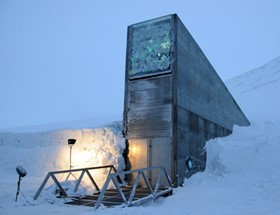
Figure 3: The Svalbard Global Seed Vault is a storage facility for seeds of Earth’s diverse crops. (credit: Mari Tefre, Svalbard Global Seed Vault)
The Svalbard seed vault is located on Spitsbergen island in Norway, which has an arctic climate. This arctic climate is good for seed storage because the ground is permanently frozen so the seeds will keep, even if the electricity fails.
Although crops are largely under our control, our ability to grow them is dependent on the biodiversity of the ecosystems in which they are grown. That biodiversity creates the conditions under which crops are able to grow through what are known as ecosystem services—valuable conditions or processes that are carried out by an ecosystem. Crops are not grown, for the most part, in built environments. They are grown in soil. Although some agricultural soils are rendered sterile using controversial pesticide treatments, most contain a huge diversity of organisms that maintain nutrient cycles—breaking down organic matter into nutrient compounds that crops need for growth. These organisms also maintain soil texture that affects water and oxygen dynamics in the soil that are necessary for plant growth. Replacing the work of these organisms in forming arable soil is not practically possible. These kinds of processes are called ecosystem services. They occur within ecosystems, such as soil ecosystems, as a result of the diverse metabolic activities of the organisms living there, but they provide benefits to human food production, drinking water availability, and breathable air.
Other key ecosystem services related to food production are plant pollination and crop pest control. It is estimated that honeybee pollination within the United States brings in $1.6 billion per year; other pollinators contribute up to $6.7 billion. Over 150 crops in the United States require pollination to produce. Many honeybee populations are managed by beekeepers who rent out their hives’ services to farmers. Honeybee populations in North America have been suffering large losses caused by a syndrome known as colony collapse disorder, a new phenomenon with an unclear cause. Other pollinators include a diverse array of other bee species and various insects and birds. Loss of these species would make growing crops requiring pollination impossible, increasing dependence on other crops.
Finally, humans compete for their food with crop pests, most of which are insects. Pesticides control these competitors, but these are costly and lose their effectiveness over time as pest populations adapt. They also lead to collateral damage by killing non-pest species as well as beneficial insects like honeybees and risking the health of agricultural workers and consumers. Moreover, these pesticides may migrate from the fields where they are applied and do damage to other ecosystems like streams, lakes, and even the ocean. Ecologists believe that the bulk of the work in removing pests is actually done by predators and parasites of those pests, but the impact has not been well studied. A review found that in 74 percent of studies that looked for an effect of landscape complexity (forests and fallow fields near to crop fields) on natural enemies of pests, the greater the complexity, the greater the effect of pest-suppressing organisms. Another experimental study found that introducing multiple enemies of pea aphids (an important alfalfa pest) increased the yield of alfalfa significantly. This study shows that a diversity of pests is more effective at control than one single pest. Loss of diversity in pest enemies will inevitably make it more difficult and costly to grow food. The world’s growing human population faces significant challenges in the increasing costs and other difficulties associated with producing food.
Wild Food Sources
In addition to growing crops and raising food animals, humans obtain food resources from wild populations, primarily wild fish populations. For about one billion people, aquatic resources provide the main source of animal protein. But since 1990, production from global fisheries has declined. Despite considerable effort, few fisheries on Earth have managed sustainability.
Fishery extinctions rarely lead to the complete extinction of the harvested species, but rather to a radical restructuring of the marine ecosystem in which a dominant species is so over-harvested that it becomes a minor player, ecologically. In addition to humans losing the food source, these alterations affect many other species in ways that are difficult or impossible to predict. The collapse of fisheries has dramatic and long-lasting effects on local human populations that work in the fishery. In addition, the loss of an inexpensive protein source to populations that cannot afford to replace it will increase the cost of living and limit societies in other ways. In general, the fish taken from fisheries have shifted to smaller species and the larger species are overfished. The ultimate outcome could clearly be the loss of aquatic systems as food sources.
Leading Theories for How Biodiversity is Maintained in a Community
Biodiversity is good for not only the practical human uses discussed above, but also because research has shown that having more biodiversity leads to stability. For example, in a classic study, Huffaker (1958) used two species of orange mites, one a predator species (Typhlodromus occidentalis) and one a prey species (Eotetranychus sexmaculatus) to study the issue of diversity. When the two species were found in a “monoculture” environment of only oranges as their habitat, the predator species quickly found and ate the prey species and then starved itself so the system went extinct within two months. When foodless positions (rubber balls) were added to the habitat to increase spatial heterogeneity, the predator and prey species were able to live together longer before going extinct – almost 3 months. Adding still to the complexity of the environment, Huffaker added Vaseline barriers to the habitat. This allowed the prey species of orange mite to “get away” from the predator species more quickly as the prey species could use a silk thread like a spiderman get-a-way. The system eventually went extinct, but again, coexistence and stability lasted longer, almost 8 months. The more diverse the habitat, the more stable.
There are two leading theories explaining how biodiversity can be maintained in a given area: Island Biogeography and Intermediate Disturbance. There is evidence for both and both have been used by conservation biologists and wildlife managers to help maintain biodiversity in an area.
Island Biogeography was first studied with small patches of land surrounded by water (islands); however, an island can be any area of land that is isolated. For example, a park surrounded by development could be an island. A mountaintop could also be considered an island. Island Biogeography states that species diversity is driven by island size and island distance from the mainland. Smaller islands should have more competition between species and fewer niches than larger islands and therefore support fewer numbers of species, all other things being equal. Distance from the mainland and the source of organisms should influence who gets to an island and therefore how many species are supported on that island. It is more difficult to reach (swim, fly, hitch a ride on a log, etc.) islands that are further away from the mainland and therefore we expect species numbers to drop as distance increases. When we take into account distance and size of island, we will see an intersection, and this is the predicted number of species that can be supported on the island. The rate of immigration to an island will be high at first since there is no competition at first and open niches; however, as species settle on the island, competition increases, niches fill, and immigration decreases (FIg 4 – blue line). And for this reason, we find extinction of the species increases over time as well. It is harder to stay established with competition with other species and niche spaces filling up (Fig 4 – green line). The intersection of these two lines is the predicted number of species that will be maintained on that island (Fig 4).
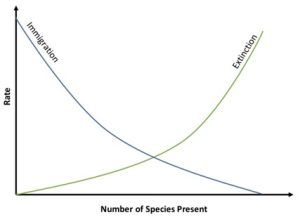
Figure 4: This graph portrays the immigration rate of new species and the extinction rate of resident species versus the number of species present on an island. The intersection point gives the equilibrium number of species. Marcus Lapeyrolerie, CC, via Wikimedia Commons.
This theory was originally proposed by E.O. Wilson in the 1960s. He was studying ant communities on Pacific islands and noticed that species richness on islands was different depending on the size of the island and even if new species appeared, the species number stayed statistically the same as that equilibrium number was reached. That is some species went extinct if others colonized the area.
Although it was in the 1960s when this idea was put forth, it is interesting to consider a “test” of the theory that occurred years prior. In 1883, there was a huge volcanic explosion on the island of Krakatoa that decimated everything (Fig 5). This small island is near Indonesia, Sumatra, and Java. There was a bestseller written by Simon Winchester called “Karkatoa: The Day the World Exploded August 27, 1883” describing the events. In the book, we can read:
“In the aftermath of Krakatoa’s eruption, 165 villages were devastated, 36,417 people died, and uncountable thousands were injured – and almost all of them, villages and inhabitants, were victims not of the eruption directly but of the immense sea-waves that were propelled outward from the volcano by that last night of detonations.”
And
“…the overall conclusion remains inescapable, both to historical anecdote and to science; the sound that was generated by the explosion of Krakatoa was enormous, almost certainly the greatest sound ever experienced by man on the face of the earth. No manmade explosion, certainly, can begin to rival the sound of Krakatoa – not even those made at the height of the Cold War’s atomic testing years. Those other volcanoes that have exploded catastrophically in the years since decibel meters were invented – Mount St. Helens, Pinatubo, Unzen, Mayo – have not come close: not one suggests that the explosion of Mount St. Helens in May 1980 was heard much beyond the very mountain ranges in which it was sited.” and yet the explosion of Krakatoa could be heard around the world!”
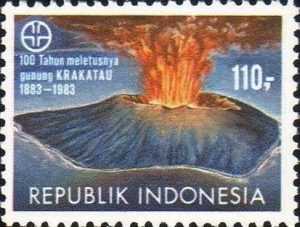
Figure 5: A stamp of Indonesia from 1983 showing the Krakatoa volcanic eruption. Post of Indonesia, Public domain, via Wikimedia Commons
After the explosion, and within 25 years, 13 species of birds had recolonized the island. By 1919, another 11 years later, 28 bird species were present, and by 1932, another 13 years later, 29 bird species were present. The equilibrium or “set” number of species was found. After this time, some species went extinct and others became established, but it always bounced around 29 to 33 species. As island biogeography theory predicted, the rate of increase declined as more and more species colonized the island and an equilibrium number of species was found.
Ecologists can apply this theory to help manage reserves, determine the ideal number of species to catch in fisheries, or with conservation efforts in general. For example, scientists can use the principles of island biogeography to help with the construction of wildlife corridors. These are patches/strips of land that can connect two wildlife areas to one another to allow for flow or migration between patches (Fig 6).
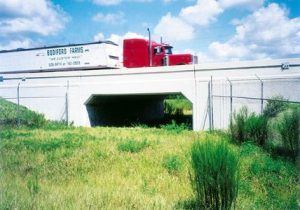
Figure 6: A bear underpass wildlife corridor. Notice this space will allow wildlife to pass freely from one natural area to another without having to cross a dangerous highway. Florida Department of Transportation (FDOT) and the Florida Fish and Wildlife Conservation Commission (FWC) designed this first underpass for the state on a stretch of State Route 46 in Lake County. U.S. Dept. of Transportation, Public domain, via Wikimedia Commons.
Watch this video as a great review on Island Biogeography Theory.
A fun simulation is available for you to explore Island Biogeography more fully. Click here to launch the Virtual Biology Lab. Read the “Tutorial” and then “Run Experiments” so you can test things out yourself.
Another theory that has a lot of support is the Intermediate Disturbance Theory. To explain why we find the number of species we do in a community, we can look at the frequency of environmental turmoil. The Intermediate Disturbance Theory states that moderate levels of disturbance can create conditions that foster greater species diversity than low or high levels of disturbance. It predicts that at low levels of ecological disturbance, species richness decreases as competitive exclusion increases and that at high levels of disturbance, species richness is decreased due to an increase in species movement, limiting the ability of any species to establish itself. Disturbance occurs too often to allow for many species to take a foothold in the area. The region of intermediate disturbance, just like the “Goldilocks idea” is just right. There is disturbance every once in a while, to prevent one species from taking over and there is not constant disturbance so that species can get established (Fig 7).
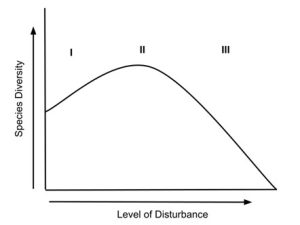
Figure 7: This graph shows the theory of Intermediate Disturbance. Area I is low disturbance, with competitive exclusion leading to a few species. Area III is high disturbance where few species can establish themselves. Area II with intermediate disturbance shows the highest species richness. CC via Wikimedia Commons
Intermediate disturbance can be seen in a variety of ways. For example, lightning strikes and other small fires in a forest can act as a disturbance agent. We can also see this with small logging patches or a windstorm blowdown of trees. If a river meanders on land or we see a flooding event happening periodically. If a company discharges toxins or pollutants every once in a while, into the environment, this could act as an intermediate disturbance agent. Animals grazing or walking in certain areas at an intermediate rate could also serve in this capacity. In such instances, there is a trade-off between species’ colonizing ability and competitive ability, with the environment changing often enough that equilibrium and stasis never being attained.
As an illustration of this, consider the following study on macroinvertebrates living in streams. Scientists studied 54 stream sites that differed in the frequency and intensity of flood-related episodes of bed movement. The scientists assess bed disturbance during high discharge events by taking particles from the immediate area and painting them so movement could be tracked. They sampled many different species of invertebrates ranging from beetle larvae, fly species larvae, molluscs, flatworms, and crustaceans (among others). They found that indeed bed disturbance best accounted for the variation that was found in species richness, with the greatest diversity of species found in streams with intermediate bed disturbance (Townsend et al 1997).
Summary
Biodiversity, seen at the species level, the genetic level or the ecosystem level, is important for several reasons. Biodiversity enhances the stability and resilience of ecosystems. Diverse ecosystems are better able to withstand environmental changes, such as climate fluctuations or the introduction of new species. Biodiversity also contributes directly to human well-being by providing essential ecosystem services. These include clean air and water, food production, pollination of crops, and the regulation of diseases. Additionally, many species in biodiverse ecosystems contain compounds with medicinal properties. Studying biodiversity can lead to the discovery of new drugs and treatments for various diseases. Biodiversity is a rich source of genetic diversity, which is critical for breeding crops and livestock with improved traits, such as disease resistance and higher yields. Biodiverse ecosystems can play a role in regulating the Earth’s climate by sequestering carbon dioxide and influencing local weather patterns. Finally, biodiversity provides aesthetic and recreational benefits, such as wildlife watching and ecotourism.
When understanding patterns of biodiversity and species richness, we have found two compelling theories: Island Biogeography and Intermediate Disturbance. With Island Biogeography, distance from the mainland and size of the island are important factors for determining the number of species found on an island. Islands closer to the mainland are more likely to receive immigrants from the mainland, leading to higher rates of colonization. Larger islands provide more habitats and resources, making them more attractive to potential colonizers. Smaller islands often have higher extinction rates due to limited resources and higher competition. Conversely, larger islands tend to have lower extinction rates because they can support larger populations. The theory also incorporates the distance effect, which posits that islands farther from the mainland will receive fewer immigrants, leading to lower species richness.
The Intermediate Disturbance theory focuses on frequency of disturbance to explain patterns of biodiversity. Here we find that ecosystems with intermediate levels of disturbance experience higher species diversity compared to ecosystems with low or high disturbance levels. This peak is due to disturbances creating opportunities for various species to colonize and coexist, while preventing competitive exclusion by dominant species that might occur in undisturbed ecosystems. At low disturbance levels, competitive exclusion and the dominance of a few species can lead to reduced species diversity. Conversely, at high disturbance levels, the environment may be too unstable for many species to establish and persist, resulting in reduced diversity.
Questions
Glossary
References
Huffaker, CB. 1958. Experimental studies on predators: dispersion factors and predator-prey oscillations. Hilgardia 27: 343-383.
Kosal, E. 2023. Content on Island Biogeography Theory and Intermediate Disturbance Theory, as well as the Summary. North Carolina State University.
Townsend, CR, Scarsbook MR, & S Doledec. 1997. The intermediate disturbance hypothesis, refugia, and biodiversity in streams. Limnology and Oceanography 42(5): 938-949.
Utah State University. 2023. Biodivesity introduction from Biology and the Citizen (2023)
Winchester, S. 2003. Krakatoa The Day the World Exploded: August 27, 1883. Perennial Publishing.416 pp.

